Setter: breed varieties, colors and content
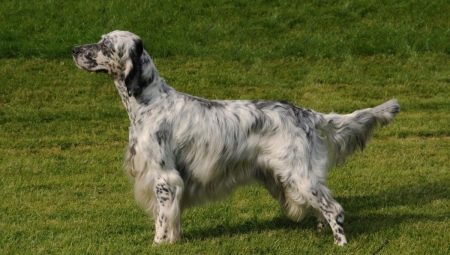
Setters are a popular hunting dog breed from the UK. These dogs differ from their relatives in a muscular and slender body, long hair, and well-developed hunting qualities. This article will discuss the varieties and colors of Setter dogs, as well as the features of their maintenance.
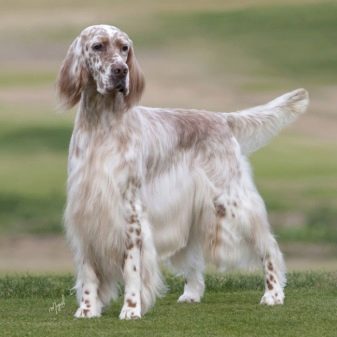
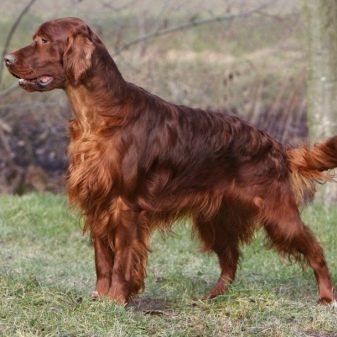
Origin story
History tells that the very first setters appeared in England in the XV-XVI centuries. The first official mention of setters was found in The Dogs of Britain from 1576. It was written by the English physician John Cayus, who already in his mature years was actively involved in the study of the question of dog populations in Britain.
The Spanish Long-haired Pointers are considered the ancestors of the Setters., which became the pioneers of many other hunting dogs. With the spread and development of hunting in England, there was an urgent need to create dogs with exclusively hunting skills and excellent physical characteristics.
Breeders and owners of pedigree hunting farms sought to create a stronger, swift and agile dog breed that would be able to work in a team and obey the hunter unquestioningly.
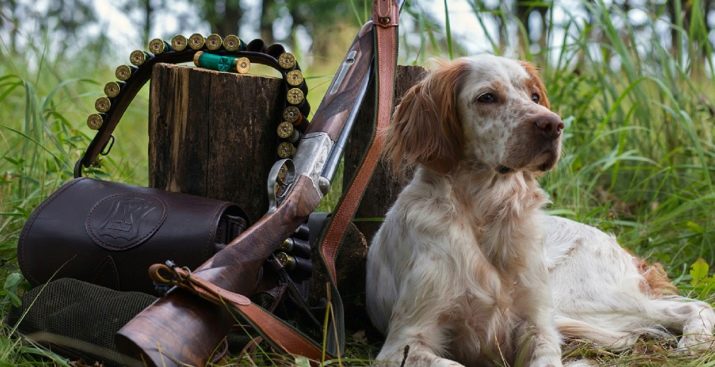
The breed creation process has undergone numerous selection experiments. If the genetic material of spaniels was taken as a basis, then over the years, to improve certain qualities, the blood of greyhounds, hounds, collies, even poodles and retrievers was added to it. Experiments on breeding larger cops led to an almost complete change in the size of the dog.The new individuals were absolutely different from the standard spaniels, so it was decided to give them their own name - setters.
The first setters were used exclusively for hunting game birds. A feature of such dogs was their manner of lying on the ground when finding prey nearby; this technique was actively used for hunting with the help of cap nets, which was popular at that time. At the same time, these dogs began to be actively used in classic gun hunting and shooting at flying and waterfowl. It is believed that the first individuals of this breed were created as a replacement for Greyhounds and bird hunters.
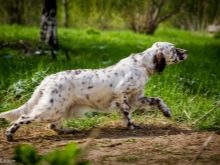
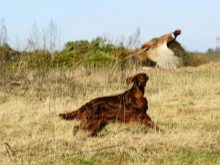
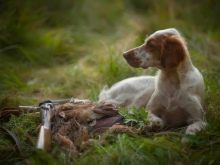
Over time, breeders have managed to achieve the perfect result - setters have become incredibly fast, prey and sensitive dogs. They were able to track down game at a distance of up to several kilometers and indicate the direction to the hunter with the help of a special hunting stand, which was finally formed only by the beginning of the 19th century.
Since the beginning of the 16th century, there has been an increase in the number of attempts to breed setters in order to create varieties of setters more adapted to certain hunting conditions. This, as well as the active spread of setters throughout Europe, led to the creation of several varieties of this breed of dog. Varieties have evolved not so much on the basis of differences in external characteristics, but because of the emergence of new ways of hunting and competition between breeders.
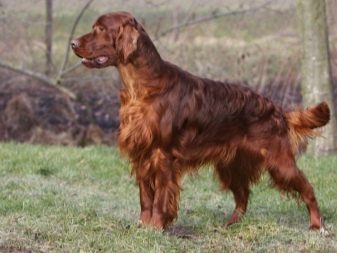
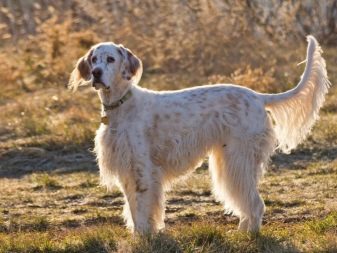
The development of setters can be seen in breed shows in the 60s of the 19th century (the first was held in Birmengham). If at the first exhibitions exclusively English breed setters were presented, then after a year and a half (by about 1861-1862) 3 types of setters have already taken part in the exhibitions: English (or Laverac), Irish, Scottish (or Gordon).
A little later, the Irish breed was split into two separate types of setter: Irish red and Irish red and white.
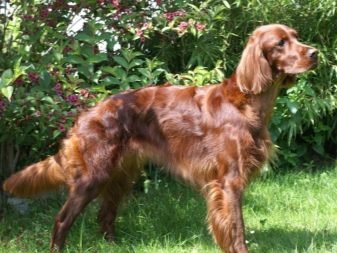
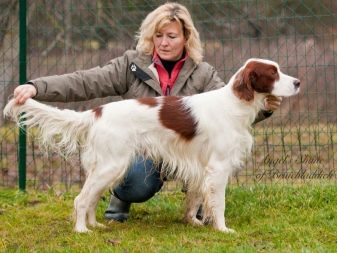
Description
The Setter dog breed is represented by several varieties with some differences in standard, temperament and hunting skills. Below will be presented a description of the main characteristics of the varieties of setters in the form of a comparative table.
Standard | English setter | Irish Setter | Scottish setter |
Height | Males - 65 to 69 centimeters at the withers. Bitches - from 61 to 65 centimeters. | Irish Setter males grow up to 66 centimeters at the withers, females up to 63 cm. | The smallest variety among the setters. Males - up to 66 cm, females - up to 62 cm. |
The weight | Regardless of gender, individuals of English setters rarely gain weight more than 30 kg. | Bitches weigh a little less than males - up to 30 kg, males - up to 34. | Relatively light weight. Bitches - up to 25.5 kg, males - up to 29.5 kg. |
Head and muzzle | The muzzle is rectangular. The distance from the tip of the nose to the stop should be equal to the distance of the skull from the back of the head to the eyes. | Long type, the skull is oval between the ears. The stop is clearly visible. The muzzle is elongated, rectangular, deep and dry. | Not particularly deep, but wide. The muzzle is oblong and rectangular, noticeably shorter than the skull. The skull is rounded, widened between the ears. Stop is clearly defined. |
Nose | Depending on the color, it can be dark, black or brown. | The nostrils are well developed. Depending on the color of the dog, it can be dark, brown or brown. | Well developed, nostrils open. The nose is predominantly dark in color. |
Jaws and lips | The jaws are powerful, of almost the same length. There is a slight "bruising" of the lips. Scissor bite. | The jaws are large and powerful, with a scissor bite. The lips are close to the jaw, dry, the same color as the nose. | Powerful jaws, no "raspiness", lips are clearly defined. Scissor bite. The upper teeth are perpendicular to the jaws. |
Eyes | A dark color should prevail - from light brown to black.The eyes are small in size, set evenly, oval in shape. | Small, oval-shaped, not very deeply set. The color of the iris differs depending on the color, mainly brown and dark. | Set flat with prominent brow ridges. The shade of the eyes is dark or chestnut. The eyelids should fit snugly against the eyeball. |
Ears | Medium in size, set on the sides of the skull, drooping. The ends are oval. The ears are covered with a thin layer of long hair. | Medium length, rounded at the tips. Set on the sides, flush with the eyes. The ears fit snugly against the cheekbones. Covered with a thin layer of wool. | Fit snugly to the head. Not long, yet quite thin. Set very low. Covered with a layer of dense wool. |
Neck | Sufficiently long, lithe and muscular, and dry. There are no folds. Expands significantly towards the shoulders. | Moderately long, but lean and muscular, characteristic feature - lateral compression. Males have a slight bulge on top. | Quite long, dry and without wrinkles. Vaulted type. |
Breast | Deep, broad and muscular. Well-developed rounded ribs. | Not particularly wide, but long and deep. All ribs are slightly arched. | Not wide, the sternum is deep, the ribs are correctly curved. |
Limbs | Muscular, set straight and parallel. The knees are well developed. The pasterns are strong and rounded. The feet are tightly knit, of medium size, with lumps of hair between the toes. | Muscular and lean, standing straight and parallel. Set wide apart. The hock joint is well defined, while the metatarsus are almost vertical. The pasterns are not particularly long. The oval feet are tucked in, there is hair between the pads. | Wide, massive and strong, set straight. The forelimbs are characterized by flat bone. The knees are well defined. Feet are oval, toes are arched, there is hair between the pads. |
Wool | Wavy, but not curly type. Hair is smooth, not springy. The length of the coat on the chest, belly and elbows is increased. | Not particularly long, but smooth-haired, close fitting to the body. Elongation of the coat is observed on all parts of the body, except for the muzzle, head and forelegs. | On the chest, muzzle, forelegs, and at the ends of the ears, it is exceptionally short and straight. On the rest of the body, it is wavy, silky, rather elastic. A prerequisite is the presence of burn marks: above the eyes, on the sides of the muzzle, on the throat and chest, on the paws, around the anus. |
Color | Speckled, marbled, orange-speckled or golden-speckled mottled hide. From tricolors - brown speckled with tan. | Sometimes it is monochromatic with a predominance of brown, red or red shades. Light zones on the muzzle, bast and crown of the head are allowed, and two-color, which is characterized by a red-white color with a predominance of one of the shades. | Very rich, dark chocolate or charcoal black. The tan markings are red, chestnut or dark orange. |
Movement | Graceful, light and confident, fast. The hock joint provides a powerful initial speed. | Light and slightly sweeping, graceful. | Free and correct, even. |
Tail | Not particularly long, erect, feather-shaped, saber-shaped. In a calm state it reaches the height of the hock joints, in an excited state it is raised. | Feather type, small size, saber-shaped. The length in the lowered state should go down to the hock. | Straight, saber-shaped. Tapered towards the tip, feather-shaped with long hair on the inside. |

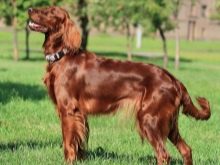
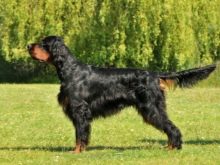
Character
For all varieties of setters, approximately the same character traits are characteristic.
In relation to their family and owner, setters always remain cheerful, companionable and good-natured. They will not follow you on your heels, but they will watch your work with interest, will agree to any games and fun, unquestioningly obey commands and assignments with the right upbringing.
Unfortunately, these dogs are not suitable either as protectors or watchdogs.
When they see strangers or guests, they will become interested and show signs of sympathy rather than wariness. It is very easy to win the trust of these dogs - they adore affection, delicacies and attention.
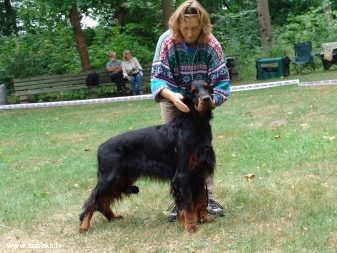
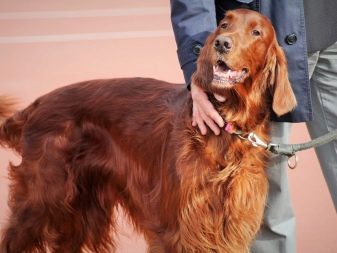
Experienced breeders advise against leaving these pets alone with small children. Setters are playful and love all kinds of games, but they are very negative about constant harassment and teasing. Setters get along well with children over 8 years old.
If the owner does not determine in time who is in charge in their relationship, it is likely that in the future he will face the problem of establishing his authority. Mismanaged setters grow up to be surprisingly moody, vicious, and unbalanced.
Setters do not like to share the owner and their family members with other pets. They want all the attention to be always directed to them. Their large size, speed, and remarkable strength give them a sense of impunity in belittling other pets.
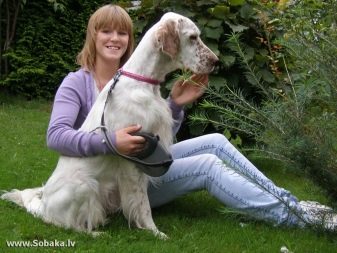
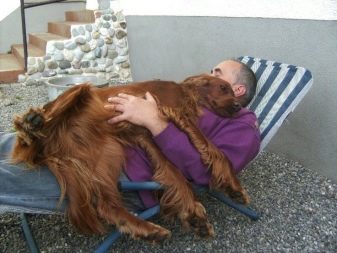
Life span
Setter lifespan varies slightly depending on their variety.
- english Lewellin setters or setters live on average 11 to 15 years;
- Irish red setters live from 12 to 15 years, red and white - from 10 to 13 years;
- scottish setters don't live longer than 12 years on average.
Do not forget that these are only general statistics - proper care, care and proper nutrition can increase the life of your pet by several years.
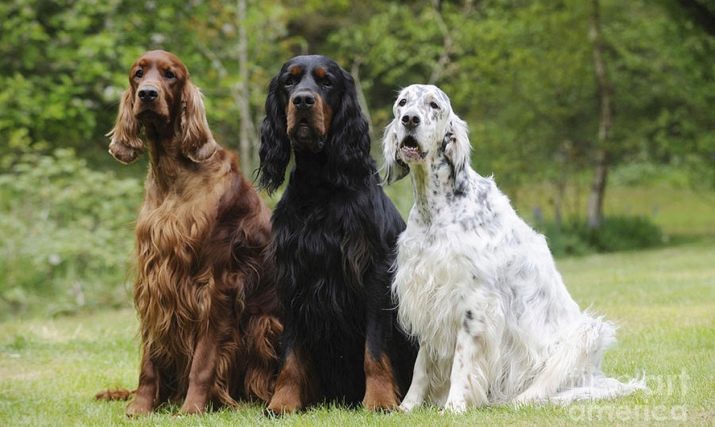
Varieties
As mentioned above, today there are several official varieties of setters. To more accurately reflect their differences from each other, you should refer to the history of their occurrence.
English (Laverac)
Modern English Setters have evolved from the crossbreeding of many European hunting dog breeds. The first specimens of this breed were created in the 16th century in France by crossing the Spanish and French pointers. From the 17th to the 18th century, there was a real technological boom that affected the functionality of hunting rifles.
This has led to attempts to create more hardy, faster breeds with good stance.

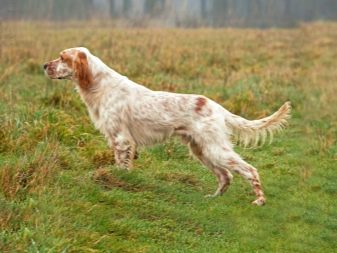
The unofficial pioneer of the English Setter breed is Eduard Laverac, who in 1825 began active work on breeding a certain type of hunting dogs. It was thanks to Laverac's activities that the English setter was given its unofficial second name. The breeding research of the breeder lasted about 35 years, during which time, through rigorous selection, the first rough standard of modern English setters was created.
These dogs were extremely fast, intelligent and hardy, they also knew the terrain perfectly, were obedient and not aggressive towards other dogs. In addition to the activities of Laverac himself, his assistant P. Lewellin, who in the future became his competitor, took an active part in the creation of these setters. Later, the individuals bred by his assistant acquired their name - Lewellin setters.
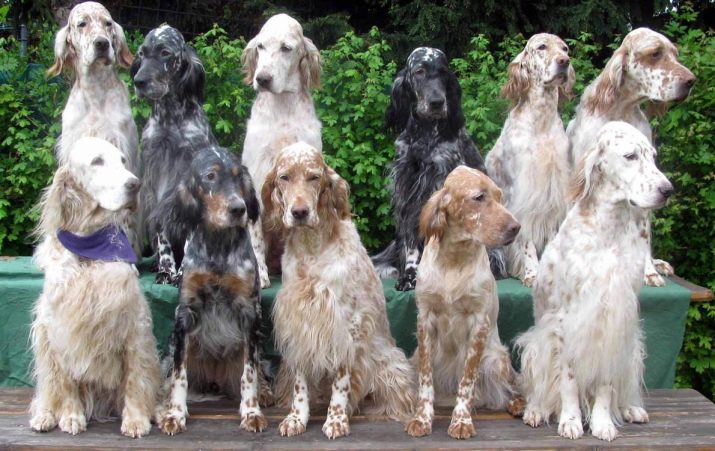
The genetic material of the individuals of the English setters served as the basis for the creation of other varieties of this breed of dogs. Numerous experiments on the exterior and color of these dogs led to the appearance of mestizo - individuals with a non-standard color, disproportionate physique, short limbs and a muzzle.
Especially badly, these experiments affected the individuals of the setters that first came to the territory of Russia. Due to the lack of experience in breeding hunting dogs, Russian breeders actively crossed setters with local breeds.The initial idea was to create a stronger, more resilient and unpretentious setter for the Russian climate, but these attempts ended in failure due to insufficient genetic material and pedigree individuals. All dogs obtained in this way are today called the "Russian" variety of setters.
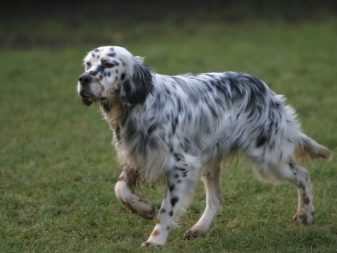
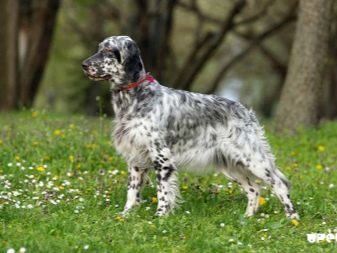
Scottish (Gordon)
By the beginning of the 18th century, setters existed only as a generalized breed with many colors, variations in size and conformation, but this did not prevent them from falling in love with breeders on all British Isles. Many of them have decided to standardize these breeds - to fit them into a single whole in order to preserve the breed qualities.
One of these enthusiasts was the Scottish Duke Alexander Gordon (1743-1827).
From childhood, the duke was passionate about hunting, and also owned a whole nursery of Scottish deerhounds. Very soon, he set a goal to create a separate breed of black and tan type setters, but with the preservation of all hunting qualities. There is reason to believe that to create individuals with this color, the duke crossed setters with individuals of deerhounds. The result of these experiments was the complete exclusion of white setters from the color, as well as the creation of a separate nursery specifically for individuals of Scottish setters.
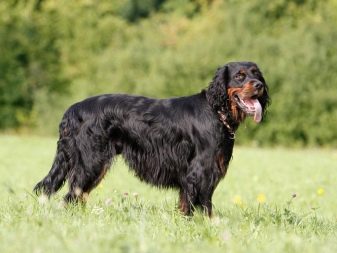

Thanks to the activities of this breeder, the new breed of setters was able to spread widely throughout Britain. Very soon, the breed was named after the Duke - Gordon Castle Setter, but the prefix "Castle" in the name disappeared over time, due to which this breed of dogs began to be called simply Gordon Setters.
The first specimen of the Gordon Setter appeared on the territory of America only in 1842. and she was brought directly from the nursery of the Duke of Gordon. It is noteworthy that the Scottish Setters became one of the first breeds recognized by the American Kennel Club in 1884. This is why these dogs are sometimes called "American Setters".
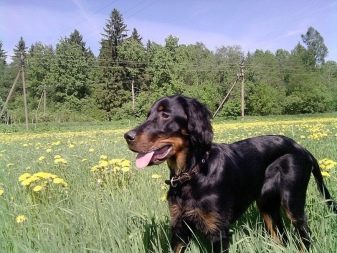
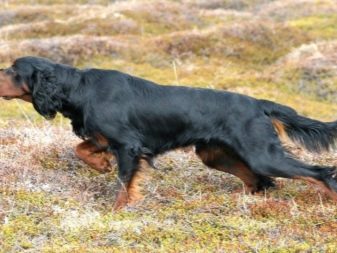
Irish
Irish Setters appeared much later than other varieties of this breed. It is believed that these dogs descended from the black and white English setters, to which the blood was later added to other European hunting dogs: Gordon setters, Bloodhounds, Irish water spaniels. The result of this selection was the creation of Irish setters with a red color, but the experiments on the appearance of the dogs did not end there.
It should be noted that there was an unspoken rivalry between Irish breeders and hunters at that time. Each of them strove to create a more original color in their Irish setter, which led to the emergence of several breed lines at once. The most common colors were red (with a dark muzzle) and red-white.
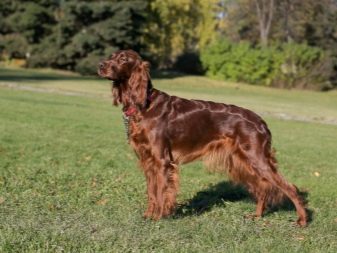

Regardless of color, a certain list of requirements for inclusion in the standard was presented to the Irish setters: hard work, lack of fear of water and noise, harmonious small size, hardy and muscular body, developed sense organs (especially hearing and scent), dense coat and undercoat.
Over time, these dogs have spread more and more across Britain and throughout Europe.

This led to the fact that at one of the breed shows in 1859, as many as 60 individuals of this breed were presented. This excitement led to many controversies - the breeders could not decide which of the dogs would represent the standard. The result of these disputes was only tribal records of the existence and breeding of individuals of this breed, which was also of great importance.
A little later (in 1877) Irish Red Setters came to America, where they made a splash. However, with the popularity of this breed, there was a danger of the disappearance of its working qualities - many American breeders gave preference to the features of the exterior, but not to hunting skills.In fact, this led to the emergence of two separate varieties of dogs: working and show class.
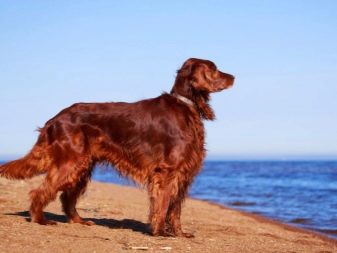

How to choose a puppy?
Before buying a setter puppy of any variety, you should familiarize yourself in detail with the standard of a particular breed. By about three months of age, the exterior of the setter puppies is fully formed, which will allow you to evaluate its external data and not stumble upon pitfalls in the future.
If you are purchasing a setter puppy for hunting activities, then be sure to read all the diplomas and awards of his parents for working qualities... It will be useful to find out the exterior assessments of the parents in the ring. In addition, you should examine the veterinary passports of the parents to find out possible diseases and predispositions of your pet.
Be sure to pay attention to the condition of the room where the pregnant bitch was., as well as the places where the puppies themselves were kept. Find out what food was given to the bitch and puppies after they were born. This will make sure your puppies are well fed and will make it easier to tailor the diet to your pet's needs. Make sure you have vitamin supplements in your young setter's diet.
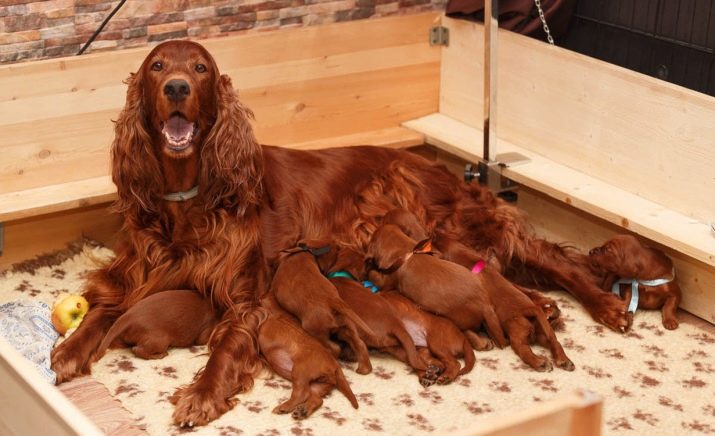
The selected puppy should be active, cheerful and confident. You should not give preference to individuals who sit far in the corner and do not touch food. Pay close attention to the movements of the puppy, they should be free and active.
Limping, wringing its paws and falling is a wake-up call regarding the integrity of the dog's skeletal system.
Examine the condition of the pet's coat, it should be dry near the genitals and anus, without bald spots and pressure sores. Take a look at the condition of the skin - the puppy should not have wounds, redness, itching. The presence of fleas and lice is another aspect of the breeder's oversight in keeping a pet. Excess weight or, conversely, protruding bones - another warning sign to think about whether to buy a puppy.
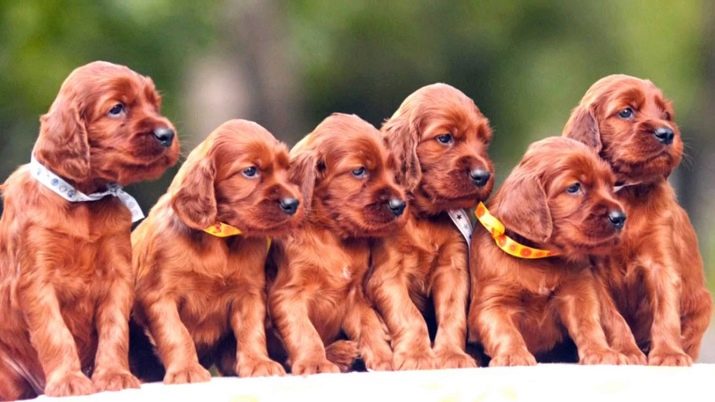
Before buying, find out the number of puppies in the litter, and also check how many of them were culled. It will also be useful to ask for photos of puppies from the last litter.
Check the integrity of the package of documents when buying a puppy. There must be a veterinary passport, metric and pedigree.
Be sure to pay attention to how the seller of the puppies or the representative of the kennel behaves with the puppies and the bitch. You should not take puppies from a person who behaves aggressively and consumerist towards dogs - this has probably already caused irreparable harm to the character of the kids.
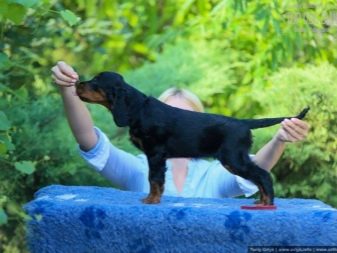
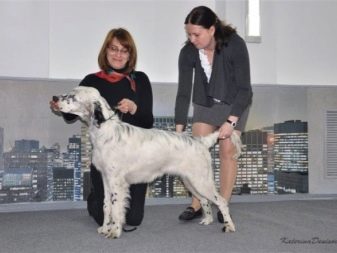
Conditions for keeping
Fortunately, setters aren't particularly picky when it comes to content. They have a very warm woolen cover, which allows them to be kept on the territory of a plot or a private house without much difficulty. If within the walls of a small apartment these dogs can feel embarrassed, then the street fully reveals their potential for activity. The ideal option for these dogs would be a high-fenced area with ample space for games and entertainment.
It is not recommended to keep these dogs in small apartments. The body of the setters constantly needs training and stress, without which these pets become passive and lack of initiative. On the streets, a setter can cause a lot of trouble for its owner. - at the slightest smell of street birds and animals, these dogs literally lose their heads and do not obey any commands. Experienced breeders believe that these dogs need a long walk for 1 hour or more, rather than a busy one.

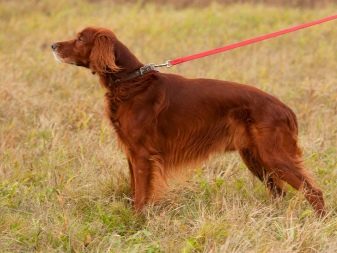
If the setters have been unable to release their energy while walking, be prepared for them to find a way to release it within the walls of your apartment.
Setters are incredibly social dogs. Despite their external independence, they love to be close to the owner and are very bored in his absence.Try to devote more time to ordinary conversations with your dog - the setters really appreciate when they communicate with him on an equal footing.
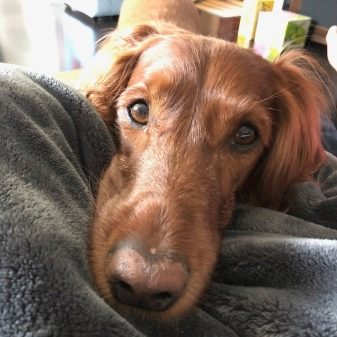
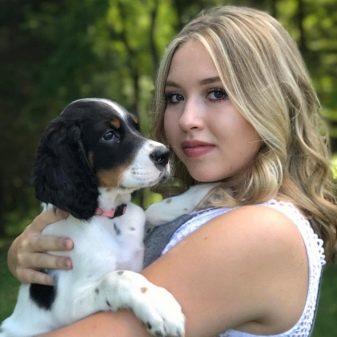
What to feed?
Correct feeding guarantees not only good health and immunity, but also a cheerful mood in the dog. Setters are not picky about food, they can easily digest both ready-made food (not necessarily the highest class) and natural products. The main condition for feeding setters is a balanced and vitamin-rich diet.
The diet of setters should always be based on meat, namely beef, chicken and turkey. The main condition here is a low fat content in it. As a substitute, offal, raw sea fish and some types of sausages are great. Natural food can be served raw or boiled, but never puree. Meat and fish should be cut into small pieces to form the correct bite.
An important element of the diet of setters is the presence of fermented milk and dairy products on the menu. This includes cheeses, cottage cheese, kefir, yogurt. In this case, it is worth considering the most low-fat products with a small amount of sugar.
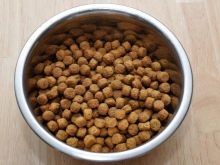
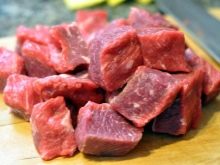
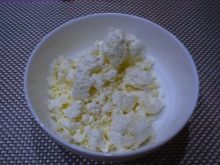
Vegetables must be present in the diet of the setters as an addition to the main course. They provide the body with the necessary vitamins, do not burden the stomach and give the pet energy for the whole day ahead. From vegetables, carrots, bell peppers, pumpkin, cucumbers and beets will look good here. Fresh herbs are also a great addition to any meal, such as parsley, dill, or salad.
In the diet of any dog, natural cereals on the water should always be present: buckwheat, rice, oatmeal. Setters should always have a full bowl of clean, fresh water at their disposal.
It is forbidden to give the setters foods that are harmful to any dog. This is any human food (smoked, salted, spicy), any sweets and bakery products.
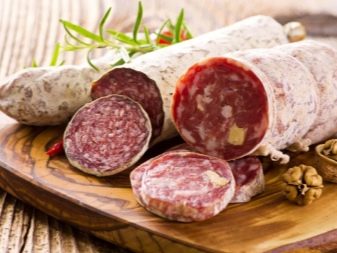
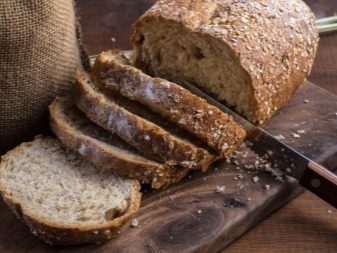
How to care?
Setters have a strong and powerful immunity, as well as a thick coat with a dense undercoat, which allows them to easily tolerate drafts, low temperatures and even moisture.
Setters, like any other breed of dog, need regular hygiene procedures.
They should clean their ears at least once a week. (which in these dogs get dirty very quickly), rinsing the eyes and brushing the teeth. It is not worth washing these dogs with shampoos, their hair practically does not retain moisture, which means that an ordinary light shower after an intense walk will be enough. Do not forget to watch your pet's claws, in the absence of physical activity and walking, they can cause significant damage to his paws, so you need to trim them periodically.

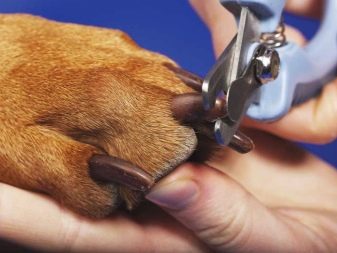
Show Setter breeds only need light coat adjustments to give them a well-groomed appearance. If we are talking about keeping dogs at home, then a haircut at the genitals, as well as on the chest, is permissible.
Wool is the only factor that many breeders do not want to see these dogs in their homes. Despite the fact that these dogs shed only a couple of times a year, after them, there is always just a huge amount of wool all over the apartment. There is only one way to deal with this - through regular combing with the help of soft combs with frequent teeth or by trimming.
Do not forget about regular vaccinations and preventive visits to the veterinarian. This will save the dog from viruses and possible diseases.

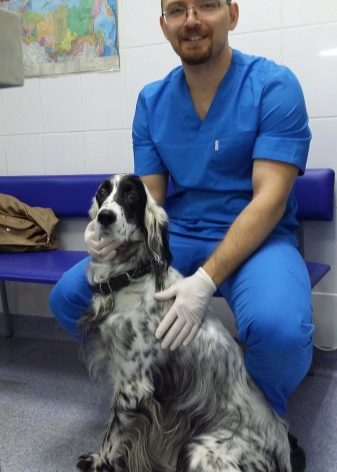
Education and training
A keen and discerning mind, as well as hunting skills, make these dogs ideal for professional training and trainings. The main task of the owner in raising setters is to achieve respect and obedience not only during training, but also in everyday life.These dogs need a firm hand to control them even when the dog is agitated. To establish such authority, it is advised to resort to the following actions:
- the pet should start eating only after you;
- train the setter not to move away from you for long walks;
- it is you who always enter the room first, and then the pet.
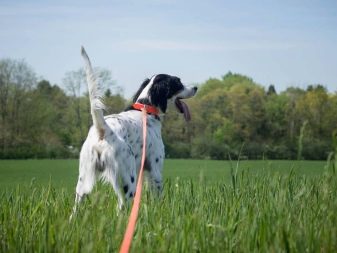
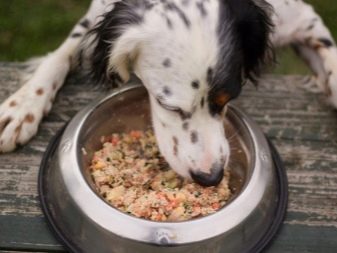
If you once allowed the setter to do something forbidden, in the future he will no longer pay any attention to your inhibitions regarding this action.
Establish rules of conduct on the very first day the dog appears in the house and stop any attempts to violate them.
Do not use any form of violence; only express dissatisfaction through intonation or gestures. When performing tricks, do not forget to reward your pet - this will give him an incentive to improve his skills.
All activities with a setter should be conducted by one person. In the company of several trainers, the setters can get confused and will follow the orders of the most loyal and affectionate towards them. The role of such “kind trainers” is often played by children who are not able to properly express their superiority over the pet. Dogs in families where children participate in training often grow up capricious, restless and disobedient.

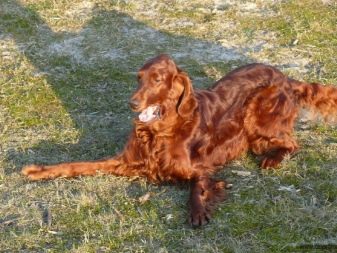
For more information on the Setter dog breed, see the next video.






































